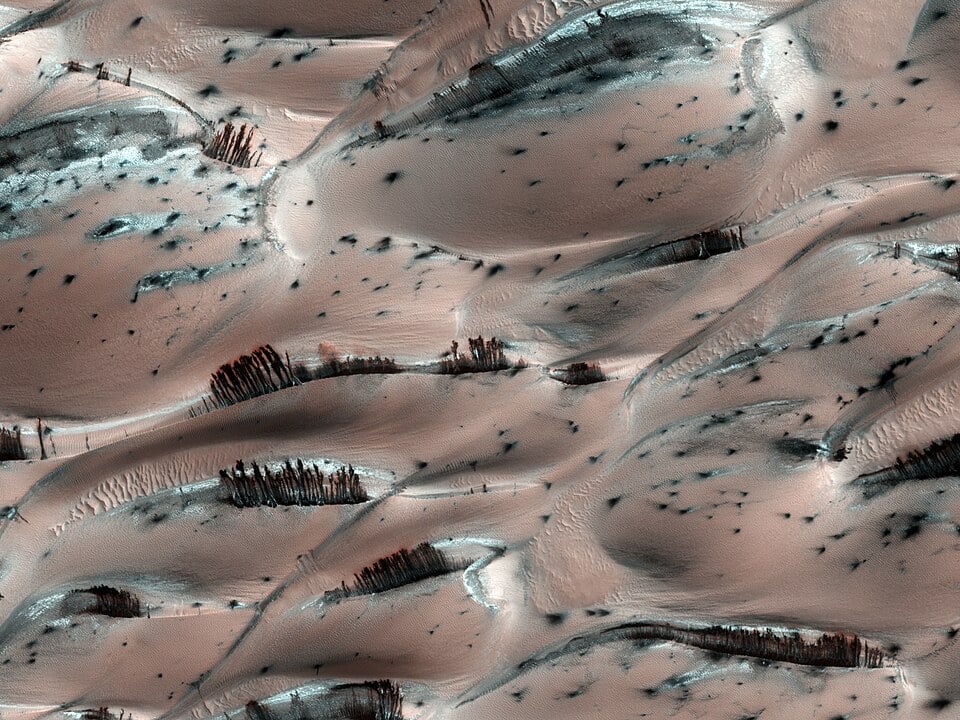In November 2022, Lauren Berger loaded a rental truck with GPS equipment, a drone, notebooks, sample bags, and a flat spatula affectionately called a "scoopula." Her destination was California's Algodones Dunes, a sandy region bordering California, Arizona, and Mexico. Her mission was to unlock the secrets of Mars by studying Earth's desert patterns.
As a graduate student at Texas A&M University, Berger is pioneering research that bridges two worlds separated by 223 million kilometres. By comparing sand dune formations in California with similar structures on Mars, she's creating the first database of compound dunes on the Red Planet, work that could prove essential for future human missions to Mars.
 Groups of dark brown streaks have been photographed on Martian dunes by the Mars Reconnaissance Orbiter on melting pinkish sand dunes covered with light frost. (Credit : NASA/JPL/University of Arizona)
Groups of dark brown streaks have been photographed on Martian dunes by the Mars Reconnaissance Orbiter on melting pinkish sand dunes covered with light frost. (Credit : NASA/JPL/University of Arizona)
The Algodones Dunes provided the perfect natural laboratory for studying the geological features shaped by wind. These formations, which include sand ripples and dunes, are found not just on Earth or Mars but throughout our Solar System, even on Venus, Pluto, and Saturn's moon Titan.
Using drone photography, Berger captures detailed aerial images of the California dunes, then stitches them together to create maps of the study area. Back at her computer, she analyses these Earth based patterns alongside images of Mars taken by the Mars Reconnaissance Orbiter's Context Camera.
 Mars Reconnaissance Orbiter (Credit : NASA/JPL)
Mars Reconnaissance Orbiter (Credit : NASA/JPL)
The comparison process involves measuring key characteristics of both terrestrial and Martian dunes, such as their height, shape, and spacing. Since we already understand Earth's weather patterns, sand grain sizes, and wind data, these measurements provide crucial clues about Mars' atmospheric conditions, wind patterns, and surface materials.
Berger's fascination with Martian sand began when she was at NASA's Jet Propulsion Laboratory. Her task was mapping sand ripples in potential landing zones for the Perseverance rover, identifying areas where the rover might get stuck. What started as hazard assessment evolved into something more profound, recognising the patterns that ripples made across the Martian landscape. These patterns, she realised, were telling a story about Mars' environmental history and current conditions.
This early experience with Martian terrain led Berger to her current research, where her comparative analysis reveals significant differences between Earth and Mars. Martian dune fields are scattered, generally small in scale, and mainly concentrated in high latitude and polar regions, reflecting limited sand supply compared to Earth's vast sand seas. It's important to note, however, that whilst there are many differences between Earth and Martian sand, there are sufficient similarities to ensure the study carries validity.
Berger's work focuses particularly on compound dunes, formations where smaller dunes sit atop larger ones. By measuring different parts of these bedforms on both planets, she can compare similarities and differences to find clues about wind patterns, grain properties, and atmospheric conditions on Mars. The shapes and patterns of these wind-carved features serve as robust indicators of planetary wind systems. Each dune formation is essentially a geological record of the atmospheric conditions that created it, preserved in sand and time.
Understanding Martian dune behaviour isn't just academic curiosity, though, it’s practical necessity for human exploration. Mars experiences frequent dust storms, some encircling the entire planet, and understanding the surface patterns and structures will help scientists determine where to establish bases so they don't get buried by moving sand.
 Two 2001 images from the Mars Orbiter Camera on NASA's Mars Global Surveyor orbiter show a dramatic change in the planet's appearance when haze raised by dust-storm activity in the south became globally distributed. The images were taken about a month apart. (Credit : NASA/JPL-Caltech/MSSS)
Two 2001 images from the Mars Orbiter Camera on NASA's Mars Global Surveyor orbiter show a dramatic change in the planet's appearance when haze raised by dust-storm activity in the south became globally distributed. The images were taken about a month apart. (Credit : NASA/JPL-Caltech/MSSS)
As Berger continues her pioneering work, she's not just creating a scientific database, she’s building a bridge between two desert worlds. Her research demonstrates that sometimes the keys to understanding alien landscapes lie not in expensive space missions, but in careful observation of phenomena right here on Earth, proving that Earth's deserts hold the keys to humanity's safe exploration of Mars.
Source : Dune patterns in California desert hold clues that help researchers map Mars' shifting sands

